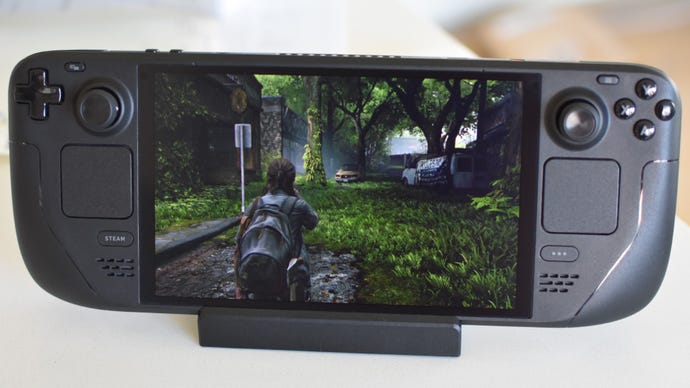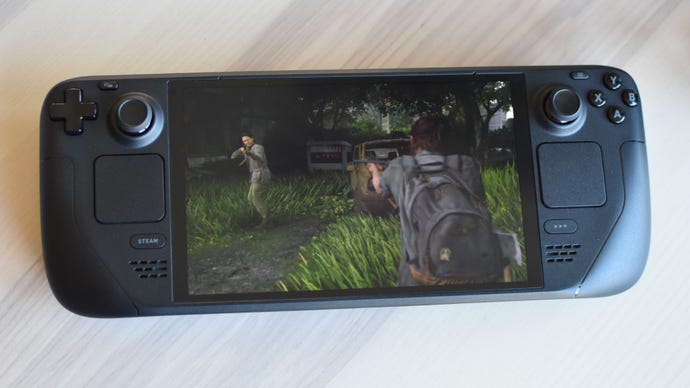I should have been more specific when I said I didn’t want developers to make distinct Steam Deck ‘versions’ of their games: while locking settings, console-style, isn’t an ideal solution to ensuring capable performance on underpowered handhelds, offering the option of full Deck optimisation is very much welcome. That’s exactly what The Last of Us Part II Remastered does, which goes a long way in explaining why it’s a far better game for portable PCs than TLOU Part I was at launch. I’d still see the bottomless blackness of those bugged-out Joel eyebrows in my nightmares, had the horror not rendered sleep impossible.
Point being, the sequel – a joint effort by PC porting specialists Nixxes and Iron Galaxy Studios, alongside original PlayStation devs Naughty Dog – is about as confident and comprehensive a Steam Deck game as you’re likely to get from the AAA crowd. It has an added quality preset named after the device itself, Cyberpunk 2077-style, while also granting access to all the individual settings you’d get on desktop, and it even goes to the trouble of including Deck-specific button glyphs on the HUD. As in, not just A, B, X, and Y symbols like you’d get from any Xbox gamepad, but icons showing an actual Steam Deck. Part I’s technical troubles were eventually fixed, but it never went that far.
Out-of-the-box performance is good here, too. The Steam Deck preset, which involves a mixture of Very Low, Low, and Medium visual settings, will easily pump out 30-45fps with the aid of Quality-level FSR 3.1. Some adroit scaling also makes sure that text or prompts remain clear and readable on the Deck’s 800p screen. That all being said, with some custom tweaks you can actually get similar framerates while keeping most individual settings on Very High – more on that below.

Part II Remastered also marks what is hopefully a permanent end to Sony’s recent experiment in demanding a PSN login for their PC ports. For the Steam Deck, whose Linux-based OS doesn’t play nice with PSN in the slightest, this has varied from irritating to ruinous, but the policy has been rolled back to the point where syncing a PSN account is merely an option in the game’s main menu. Go without, and all you’re missing out on is a bonus Ellie costume based on Naughty Dog’s upcoming space adventure Intergalactic: The Heretic Prophet. No error screens, no blocked-off modes. Nature is healing.
Once you’re in-game, everything controls smoothly – possibly more so than on a mouse and keyboard, if I’m honest – and there aren’t any further bugs or hitches that Part II Remastered doesn’t also exhibit on powerful Windows rigs. The only real concern is install size: the 150GB SSD requirement instantly rules out the 64GB Steam Deck model for onboard storage, and while nothing breaks when playing off a microSD card, load times are almost doubled compared to the Deck’s SSD. Battery life isn’t great either, sucking an original LCD Deck dry in 1h 22m, though that’s also well within expectations for a hi-fidelity 3D game. A Steam Deck OLED should last for over two hours, and from what I’ve played, also has a minor advantage in that its higher-contrast display makes it a tad easier to see where you’re going while poking around Part II Remastered’s dark, dank, Mushroom Man-infested interiors.

The Last of Us Part II Remastered Steam Deck settings guide
Conveniently – for me – the custom settings I worked out for running The Last of Us Part II Remastered on a deskbound PC are an effective guide to balancing performance visuals on the Steam Deck. Yes, it means ignoring the Steam Deck preset that the port thoughtfully included, but ultimately that makes a lot of quality cuts that aren’t really necessary. That majority of settings don’t, in fact, help or hurt framerates at all, so with just a few deeper cuts to the level of detail and texture quality settings, you can get the same 30-45fps that you would from the purpose-built preset.
To be specific, try whacking these in:
- Upscale method: FSR 3.1.0
- Upscale quality: Quality
- Dynamic resolution scaling: Off
- Level of detail: Low
- Texture quality: Low
- Image based lighting: Off
- Screen space sub-surface scattering: Cinematics only
- Motion blur quality: Off
- Everything else: Very High preset equivalent
I tend to turn off dynamic resolution options as a matter of course anyway, but it’s especially important here, as leaving it on with the 30fps target will actually reduce performance where you could be enjoying (a tangibly smoother) 40fps or more. That’s because it switches from upscaling to native 800p when the game is running above that 30fps target, even though Quality FSR looks close enough to the real thing. Unless you’re a stickler for maintaining a totally consistent framerate, then, I’d suggest disabling dynamic rez and helping yourself to the extra frames.
It seems worth reiterating, too, that these settings keep dozens of the available options at Very High, so in places it will look as good or better than the PS5 version of the remaster than launched in 2024. On a Steam Deck! It’s scarcely believable that this game even comes from the same series that, just a couple of years ago, arrived on handheld PCs creaking with duff performance and adorning its protagonist with harrowing face fuzz.
Source link











Add comment